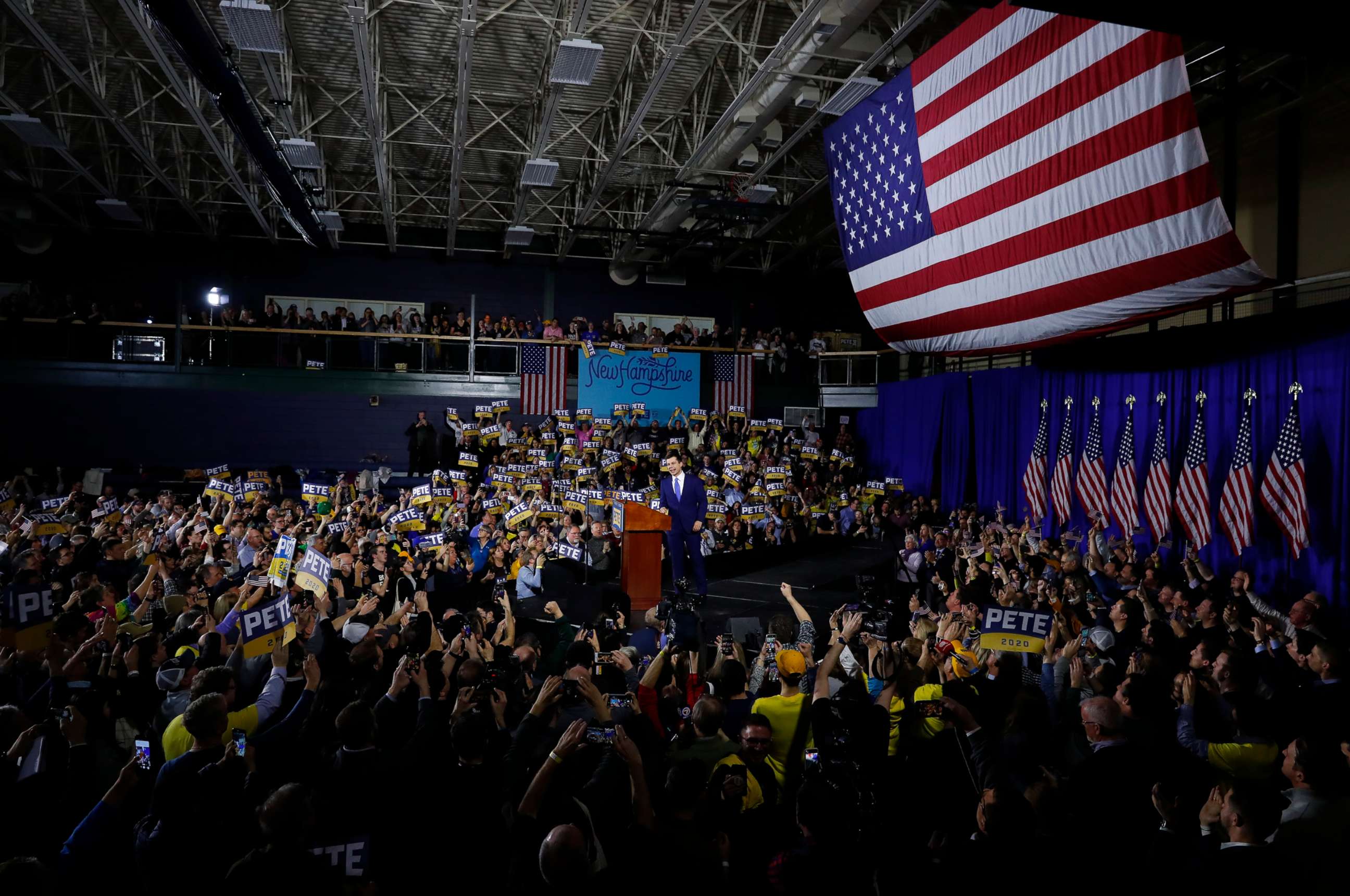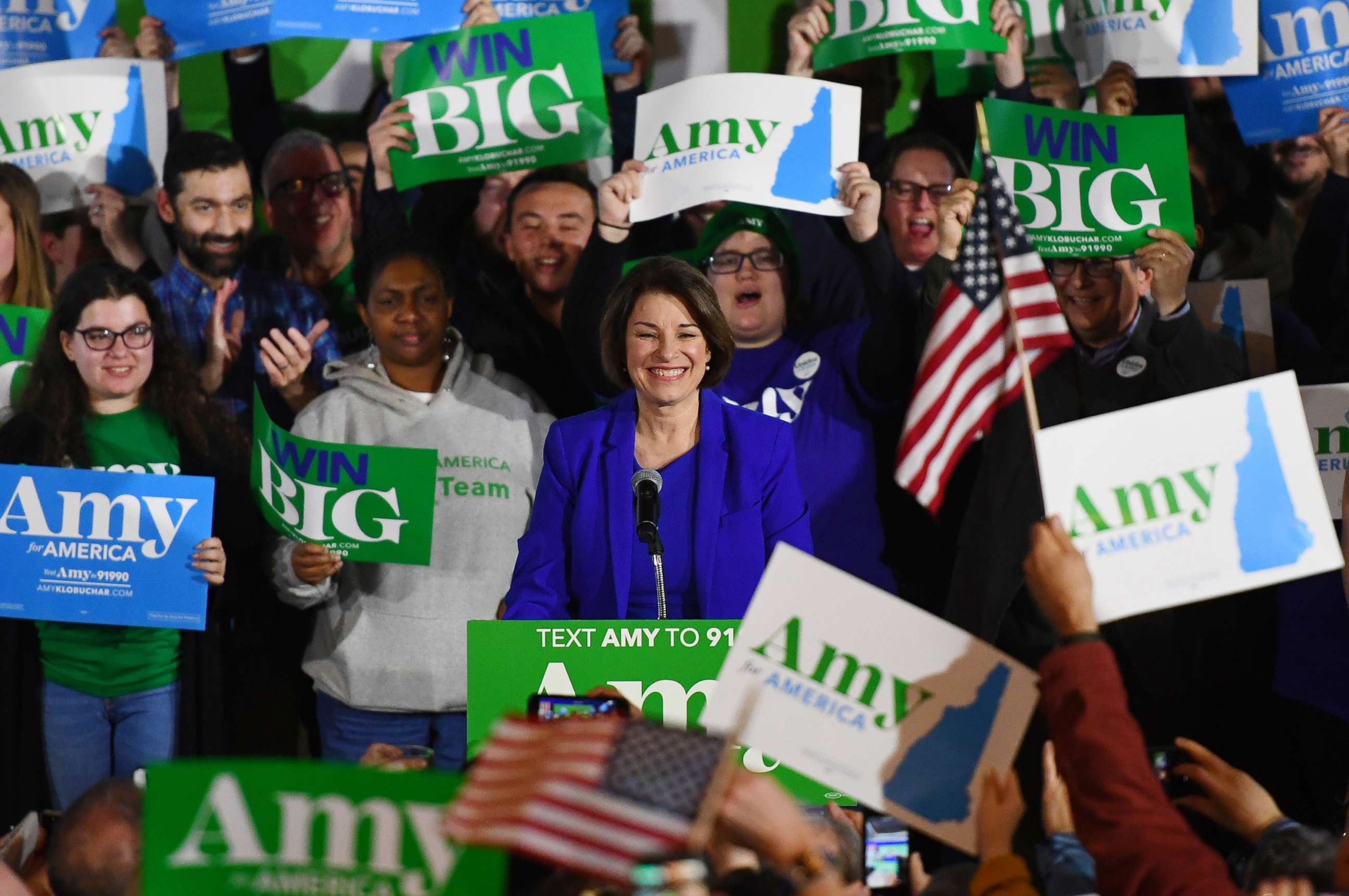Strong liberals lift Sanders, Buttigieg keeps a broad base as NH centrists bring Klobuchar into contention
Voters were united in one regard, with 78% angry about the Trump administration.
Older and more educated voters, moderates, and those looking for a candidate to unite the country lifted Amy Klobuchar to competitive status in the New Hampshire Democratic primary, largely at Joe Biden’s expense, as Bernie Sanders held on to younger and very liberal voters, and as in last week's Iowa caucuses, Pete Buttigieg demonstrated appeal across a range of groups, according to exit polling.
Whatever divided these voters, they were united in one regard: a remarkable 78% in ABC News exit poll results described themselves as “angry” about the Trump administration.
Backing someone who can unite the country was a top concern in the poll, and Klobuchar, a U.S. senator from Minnesota, split that group with Buttigieg, a former mayor of South Bend, Indiana. Klobuchar prevailed among seniors and voters with advanced degrees and ran well -- again with Buttigieg -- among moderates.
Klobuchar also led with 27% among those who called the most recent ABC News debate important in their decision, while Buttigieg won those who made their choice in the campaign’s closing days. Those late deciders accounted for a remarkable 50% of all voters, far more than in previous New Hampshire primaries.
For his part, Sanders, a U.S. senator from Vermont, produced another strong performance among younger voters -- not just under 30, but up to age 44 -- and those who called themselves very liberal, with a sweeping 51% support. He ran well but did not dominate among “somewhat” liberals, and fell back among moderates.
In contrast with Klobuchar, Sanders won voters seeking a candidate who can “bring needed change” as well as those looking chiefly for one who “cares about people like me.” Among his best groups were the six in 10 voters who back a government run, single-payer health care system. His support among those voters was triple that of Sen. Elizabeth Warren of Massachusetts, another champion of a single-payer approach.
Sanders also won handily, with 39%, among those seeking a nominee who “agrees with you on major issues.” But many more voters -- 63% -- were focused instead on the candidate who can beat Donald Trump, and there Sanders’ support fell by nearly half.

A similar result came in a question asking whether the next president should return to the policies of Barack Obama -- under whom Biden served as vice president -- or pursue a more liberal approach. Voters were divided about evenly, with Sanders soaring among those looking for more liberal policies, but cratering among those favoring a return to Obama’s priorities.
Buttigieg collected votes across an array of groups, much the same as in his top-two finish in the Iowa caucuses last week. He ran a distant second to Sanders among 18- to 29-year-olds -- a poor group for Klobuchar -- yet was also second to Klobuchar among seniors, a poor group for Sanders. Buttigieg did notably well with better-off voters, winning a third of those with household incomes of $100,000 or more.
Klobuchar, 59, and Buttigieg, 38, found some benefit from their comparative youth. With Sanders, Biden and Warren in their 70s, two in 10 voters said candidate age was an important factor in their vote, and two-thirds of them backed Klobuchar or Buttigieg.
There was a substantial gender gap for some candidates: Sanders did 9 points better with men than women, Klobuchar was 7 points better with women than men, and Buttigieg ran more evenly in both groups.
Among Klobuchar’s best groups were the 24% of voters with an advanced degree; she won 31% in this group, versus Sanders’ 19%. That included 35% of women with advanced degrees and 26% of advanced-degree men.
Klobuchar also won 29% of college-educated women, followed by 24% for Buttigieg, 21% for Sanders and just 12% for Warren. Non-college men, by contrast, backed Sanders with 37%, as Buttigieg came in a distant second in this group, with Klobuchar farther back.

For all of Sanders' strengths, the results pointed to a “too liberal” problem for the Vermont senator, who was described this way by 51% of New Hampshire voters. That group went for Klobuchar at 37% and Buttigieg at 33%, with just 11% backing Biden.
Fewer, but still 42%, also called Warren too liberal, compared with single digits for Buttigieg and Biden. The question wasn’t asked about Klobuchar.
In a multi-candidate race, Sanders couldn’t retain his support levels from 2016, when he won 60% overall in a two-way contest with Hillary Clinton. One difference: He won 29% of independent voters Tuesday, compared with 73% in this group four years ago.
Biden took a hit for running the most negative campaign; among the three in 10 who said he’d done so, he won 2% support.
Biden also had trouble among the few nonwhites in the electorate, a group whose support he’s been banking on. Sanders won 29% of nonwhites, with Biden at 20%, Buttigieg at 15% and Klobuchar at 11%. One reason is that nonwhites were somewhat younger than the whites who turned out, and, as noted, young voters favored Sanders. Still, the result raises questions for Klobuchar and Buttigieg at the next primary in South Carolina, where nonwhites (mostly blacks) accounted for 65% of voters in 2016.
In New Hampshire, Hispanics voted 40 percent for Sanders, with all other candidates registering in the teens or lower -- including 10% for Biden.
Health care was the top-cited issue among four that were tested, and Sanders won those who picked it. He also won voters focused on income inequality. Those who cared most about climate change and foreign policy tilted toward Buttigieg.

In the Republican primary, Bill Weld pulled in 18% of GOP voters with an advanced degree and 17% of moderates. He soared to 43% among Republican voters who oppose building a wall among the border with Mexico; however they accounted for just 12% of the electorate. Trump, for his part, peaked at 98% of very conservative voters and 94% of evangelical white Christians.
Turnout among conservatives in the GOP primary was at a record high, 79%, up from a previous record of 71% in 2016. That contrasted with a 61% liberal turnout in the Democratic contest, a bit off the 2016 high.
Indeed, 31% in the Republican primary were “very” conservative, again a new high. And 55% said their allegiance was more with Trump than with the Republican Party. For 40%, it was more with the GOP.
There was a sharp difference by education in the two primaries: Thirty-five percent of Republican voters were college graduates, compared with 53% of Democratic voters. All the same, GOP voters were 21 points more likely than those in the Democratic primary to say they’re “getting ahead” financially, 42% versus 21%.
There also was a customary gender difference: Men accounted for 55% of Republican primary voters, women for 57% in the Democratic contest.




